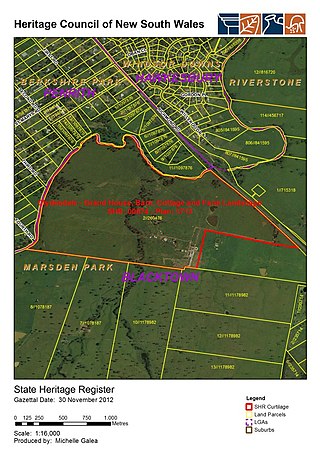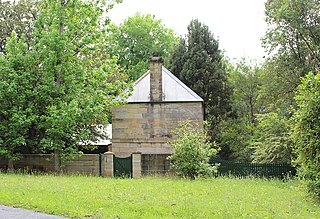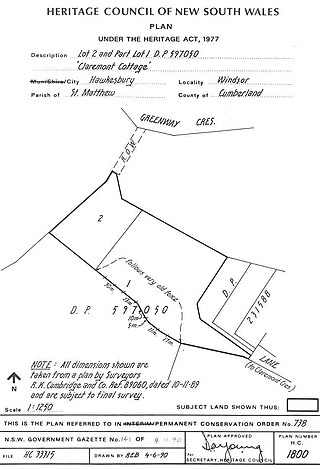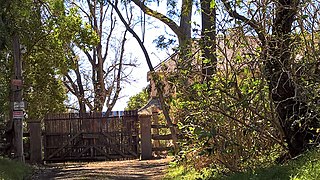
Richmond is a town in New South Wales, in the local government area of the City of Hawkesbury. It is located 19 metres above sea level on the alluvial Hawkesbury River flats, at the foot of the Blue Mountains on the Cumberland Plain. It is about 65 km by road from Sydney and about 78 km by road from Lithgow.

Elizabeth Farm is a historic estate located at 70 Alice Street, Rosehill, a suburb of Sydney, New South Wales, Australia. Elizabeth Farm was the family home of wool pioneers John and Elizabeth Macarthur. The estate was commenced in 1793 on a slight hill overlooking the upper reaches of Parramatta River, 23 kilometres (14 mi) west of Sydney Cove. The Burramattagal clan of the Dharug people are the traditional custodians of the area; their presence is recalled in the name Parramatta.

Clydesdale is a heritage-listed homestead and former seminary and missionary school (1859–71) and wartime hospital (1942–44) at 1270 Richmond Road, Marsden Park, City of Blacktown, New South Wales, Australia. It was built from 1823 to 1885. It is also known as Lang's Farm; the northern half is also known as Echovale. It was added to the New South Wales State Heritage Register on 2 April 1999.

Rose Cottage is a heritage-listed former cottage and now museum at Rose Street, Wilberforce, City of Hawkesbury, New South Wales, Australia. It was built from 1810 to 1820 by Thomas Rose. The property is owned by the Thomas and Jane Rose Family Society Inc. It was added to the New South Wales State Heritage Register on 2 April 1999.
Abbotsford is a heritage-listed former farm and residence and now vacant building located at Oaks Road in the outer south-western Sydney suburb of Picton, in the Wollondilly Shire local government area of New South Wales, Australia. It was built from 1822 to 1908. It was added to the New South Wales State Heritage Register on 2 April 1999.

Jarvisfield is a heritage-listed former pastoral property and now golf course at Old Hume Highway, Picton, Wollondilly Shire, New South Wales, Australia. It was designed by William Weaver, architect-engineer, and built from 1815 to 1864. It is also known as Wilton. The property is owned by the Wollondilly Shire Council. It was added to the New South Wales State Heritage Register on 2 April 1999.

Goldfinders Inn is a heritage-listed former inn, guesthouse, general store and post office and now residence at 164 Old Bells Line of Road, Kurrajong, City of Hawkesbury, New South Wales, Australia. It was built from 1809 to 1830 by John Lamrock. It is also known as Gold Finders Rest, Kurrajong General Store and Kurrajong Post Office. It was added to the New South Wales State Heritage Register on 21 October 2016.

Mountain View is a heritage-listed residence at 22 Inalls Lane, Richmond, City of Hawkesbury, New South Wales, Australia. It was built from 1804 to 1870 by Lewis Jones and James Vincent. It is also known as Dight's Farm. It was added to the New South Wales State Heritage Register on 2 April 1999.

Toxana is a heritage-listed residence and initial premises of the Hawkesbury Agricultural College (1891-1896) at 147 Windsor Street, Richmond, City of Hawkesbury, New South Wales, Australia. It was added to the New South Wales State Heritage Register on 2 April 1999.

Claremont Cottage is a heritage-listed residence at Claremont Crescent, Windsor, City of Hawkesbury, New South Wales, Australia. It was built from 1807 to 1822. It was added to the New South Wales State Heritage Register on 2 April 1999.

Clear Oaks is a heritage-listed homestead complex at 135 Francis Street, Richmond, City of Hawkesbury, New South Wales, Australia. It was built in c. 1809. It is also known as Moxey's Farm House. It was added to the New South Wales State Heritage Register on 2 April 1999.

Richmond Post Office is a heritage-listed former post office at 286 Windsor Street, Richmond, City of Hawkesbury, New South Wales, Australia. It was designed by Colonial Architect James Barnet and built from 1875 to 1888. The original building was built by a Mr. Johnson, with the second-story addition in 1888 added by Samuel Bought. It is also known as Richmond Telegraph and Post Office. It was added to the New South Wales State Heritage Register on 23 June 2000.

Australiana Pioneer Village is a heritage-listed open-air museum at Rose Street, Wilberforce, City of Hawkesbury, New South Wales, Australia. It was built from 1969 to 1970. The property is owned by Hawkesbury City Council. It was added to the New South Wales State Heritage Register on 20 February 2004.

Thompson Square Conservation Area is a heritage-listed precinct centred around Thompson Square in Windsor, City of Hawkesbury, New South Wales, Australia. It was added to the New South Wales State Heritage Register on 2 April 1999.
Glenmore is a heritage-listed former farm, vineyard, rural residence and private school and now golf club and function centre located at 754-760 Mulgoa Road in the western Sydney suburb of Mulgoa in the City of Penrith local government area of New South Wales, Australia. It was built from 1809 to 1868. It is also known as Glenmore Heritage Valley Golf and Country Club. The property is privately owned. It was added to the New South Wales State Heritage Register on 2 April 1999.
Cox's Cottage is a heritage-listed pasturing land and residence located at 2 St Thomas Road in the western Sydney suburb of Mulgoa in the City of Penrith local government area of New South Wales, Australia. It was built from 1810 to 1811 by James King. It is also known as Mulgoa Cottage; The Cottage, Coxs Cottage, and was formally known as Fern Hill and Estate of Mulgoa before the new house was built. The property remains privately owned and is the oldest house in Australia still in residence. It was added to the New South Wales State Heritage Register on 2 April 1999.

The New Inn is a heritage-listed former inn and now residence located at 49 - 51 Bosworth Street, Richmond, City of Hawkesbury, New South Wales, Australia. It was built from 1827 to 1927. It was added to the New South Wales State Heritage Register on 2 April 1999.

126 Windsor Street, Richmond is a heritage-listed residence at 126 Windsor Street, Richmond, City of Hawkesbury, New South Wales, Australia. It is also known as the Home of John Town and Heritage Cottage. It was added to the New South Wales State Heritage Register on 2 April 1999.

St Peter's Anglican Church is a heritage-listed Anglican church and associated Sunday school, rectory, and cemetery at 384 Windsor Street, Richmond, City of Hawkesbury, New South Wales, Australia. It was designed by Francis Clarke and Edmund Blacket and built from 1836 to 1841 by James Atkinson (church). It is also known as St Peter's Anglican Church Group, St Peter's Church Group, Church, Rectory, Church Yard, Cemetery and Stables. It was added to the New South Wales State Heritage Register on 16 August 2019; and on the City of Hawkesbury local government heritage register, and listed on the New South Wales Heritage Database on 12 September 2012.

Hadley Park is a heritage-listed former Aboriginal land, farm, dairy and gravel quarry and now unused building at 14-278 Old Castlereagh Road, Castlereagh, City of Penrith, New South Wales, Australia. It was built from 1803 to 1812. It was added to the New South Wales State Heritage Register on 20 April 2018.

















